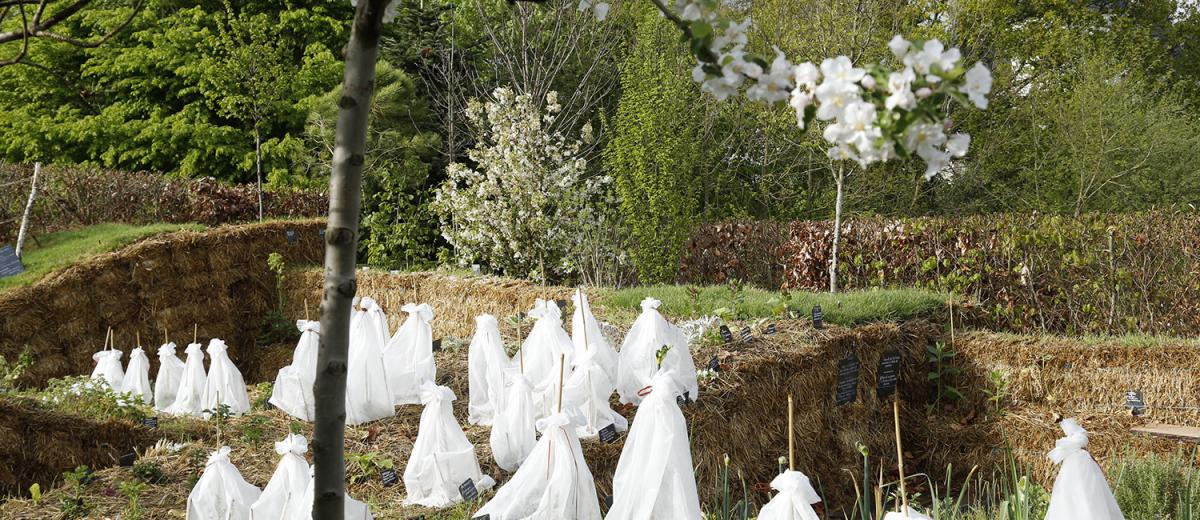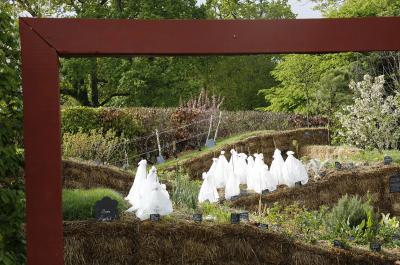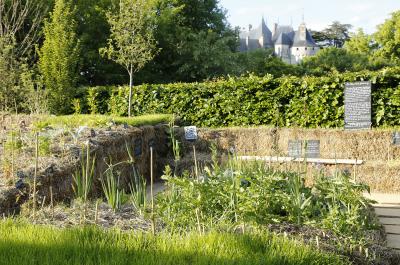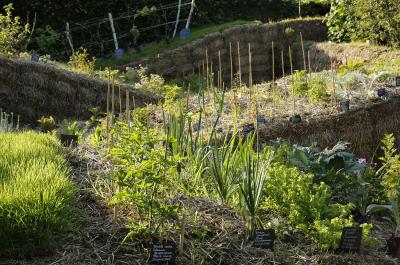Is it possible to serve a meal that cannot be tasted? Such is this garden’s challenge, as it strives to evoke taste by all the other senses that a meal calls on: for meals are a social ritual that not only stimulates the senses, but also makes sense, through sharing and conviviality, and everything that it tells us of whence it comes.
But do our meals today speak to us of common sense or nonsense? What tastes do our plates and our cuisines offer us, of what landscapes do they speak? Of standardised fruit and vegetables that have been graded, are tasteless and stripped of any vitamins, grown in industrial greenhouses or on inert soil choked with fertilizer and pesticide, picked before they are ripe and transported hundreds of miles by lorry or by plane? Or do they speak to us of produce grown locally and in vegetable patches, of varied and old seeds that nature and generations of farmers have handed down to us, of the art of associated crops, of the use of natural processing aids, of balanced landscapes shaped by such practices?
The link between a beautiful territory, delicious product and sustainable development is increasingly recognised (AOC, AMAP, Slowfood, Locavores and even many Unesco cultural landscapes). The garden “A Landscape for tasting” translates this link between the sense, the soil, the product and the people. This garden is a micro-landscape. Here, the land, the soil and the subsoil show the fragile balance that must be struck for integrated agriculture to be achieved.
Like a painting, this landscape depicts a succession of hillsides, cultivated and crowned with afforestation. The overlapping of layers of bales of straw according to the cultural technique Straw Bale Gardening is reminiscent of that of sedimentary strata, and their clear section reveals the substrate like a geological section topped with soil that evolves as the straw breaks down from above. Accordingly, like soil, the straw bears and nourishes nourishing plants, including the wheat that also produces, in turn, straw.
The garden takes us on a stroll between these structures in step with the meal and the seasons – Starter, Main, Dessert, Bread and wine, and Corridor of harvests –, for a journey deep into a landscape for tasting.
Designers
Pascale MARQ, landscape architect, Pierre-Marie TRICAUD, agronomist, government-qualified landscape architect and town-planner, Emmanuel TAILLARD, ESAJ (Higher School of Garden and Landscape Architecture) student, Laurence DU PLESSIX, decorator, and “Le Potager Extraordinaire” (Baptiste PIERRE and Yann LE YONDRE, botanist gardeners)
FRANCE
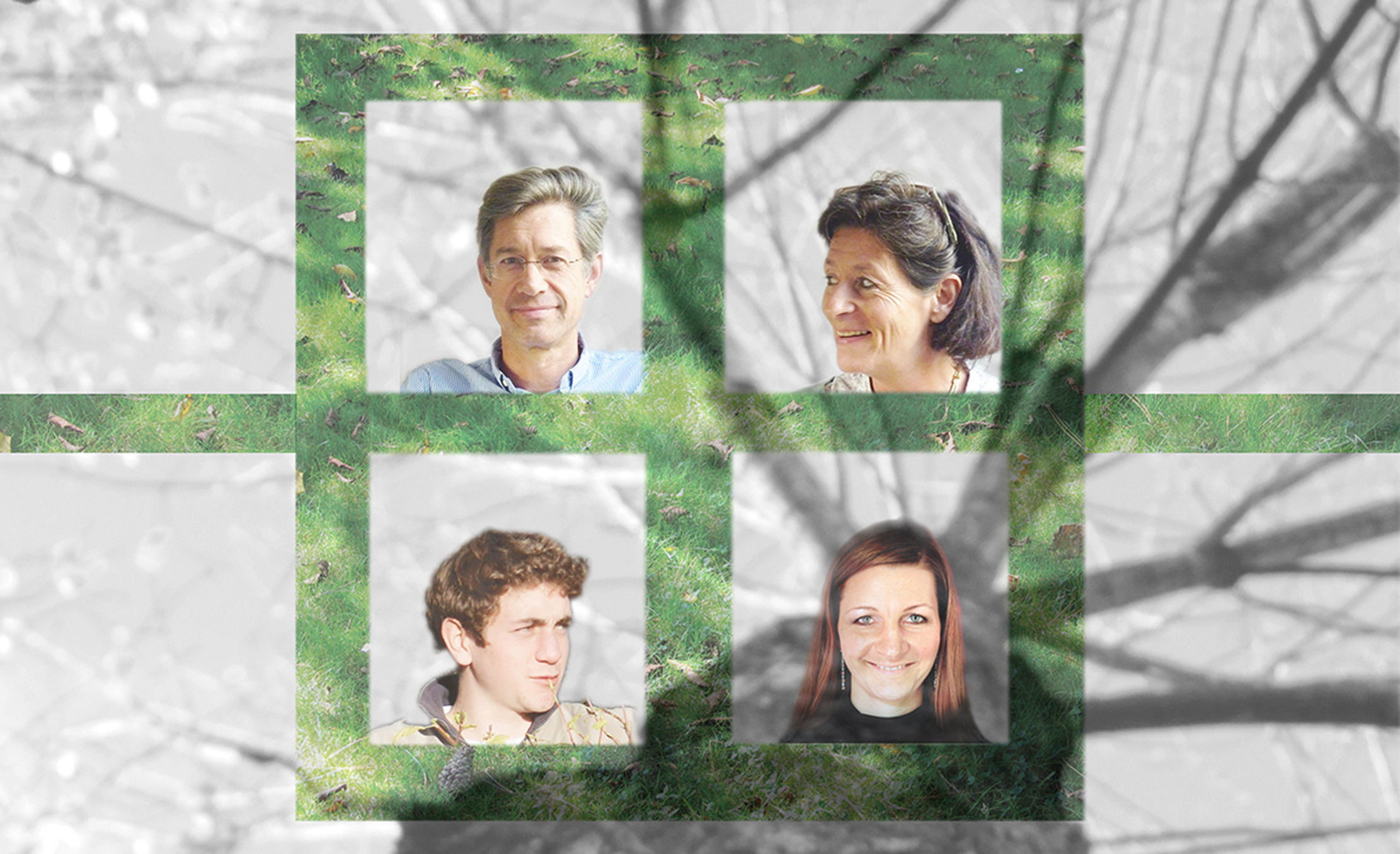
Pascale Marq creates landscapes in situ and in visu, leading a dual career as a painter and a landscape architect, specialising for several years now in development of gardens of the senses combining flowering and aromatic plants. She started her own design office three years ago and has created a wide range of gardens of all different sizes, as well as designing the maze for the national collection of irises at Château de Morchêne in Saint-Cyr-en-Val (Loiret). She has taken part in numerous exhibitions of paintings. She has been a Municipal Councillor for Isdes (Loiret) since 2008, responsible for town-planning, landscaping, architectural restoration and floral landscaping in the (2-flower) municipality, and is also a representative of the Community of Communes.
Pierre-Marie Tricaud has gone from fields to city via landscaping, being an agronomic engineer and government-qualified landscape architect, and holding a doctorate in town-planning. A former President of the French Landscaping Federation (FFP), he works at the Île-de-France Institute for Development and Urban Planning, and carries out expert assessments of World Heritage cultural landscapes for UNESCO and ICOMOS (The Loire Valley, Haut Douro, Tokaj, Causses et Cévennes, Lebanon, Champagne, etc.).
Laurence du Plessix works at awakening eye and ear alike, having always painted and made music. She has worked as an interior and event decorator and currently teaches the piano.
Emmanuel Taillard combines action with study. Having obtained a Higher Technical Certificate in Landscaping, he is studying to be a landscape architect at the ESAJ, finding time to garden whenever he can.
“Le Potager Extraordinaire” in La Mothe-Achard, Vendée, boasts a fine collection of rare vegetables from bygone days, and is recognised by the Conservatory of Specialised Plant Collections for its tomatoes and lagenaria. It is a member of the Potagers de France and an association for aid in social reintegration (President: Georges Guilloteau; project delegates: Baptiste Pierre and Yann Le Yondre).
Our team’s external advisor, Mechtild Rössler, is the UNESCO World Heritage Centre’s main specialist in cultural landscapes. She knows the eighty landscapes listed as World Heritage, many of which are productive – which is why she lends her support to actions promoting terroirs (Slow Food, AOC, etc.).
